The Mesolithic period in Andalucia was characterised by sudden changes in climate, rapidly depleting populations and corresponding increases. Not an easy time.
By Nick Nutter | Updated 24 Aug 2022 | Andalucia | History |
Login to add to YOUR Favourites or Read Later
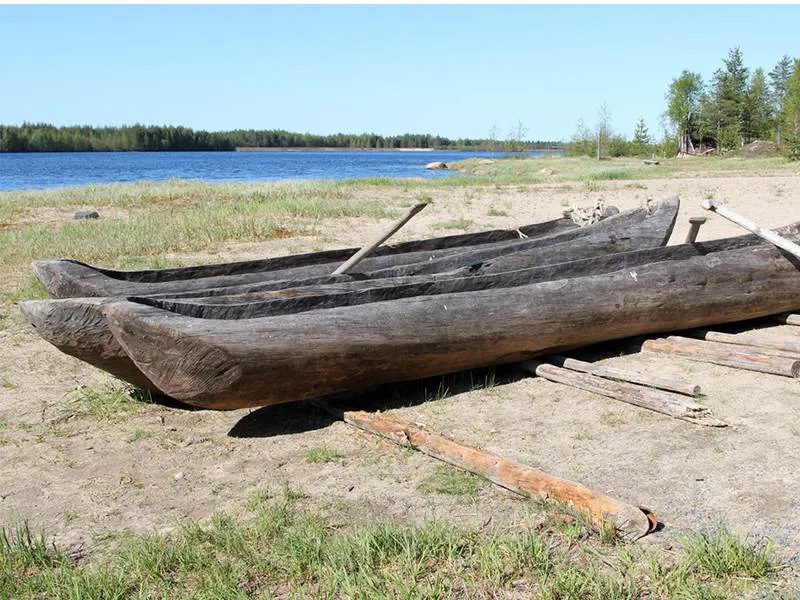
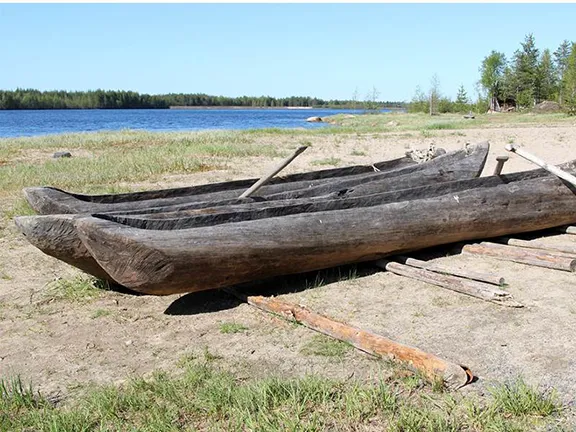
Mesolithic style canoes
The early parts of the Magdalenian proved to be a long winter for Andalucia. It was not until after about 15.5 kya that traces of humans began to trickle back into the frame from north eastern Iberia where populations, or at least the number of sites, had started to increase following a general upturn in temperatures. The tools being used were still of the Magdalenian type.
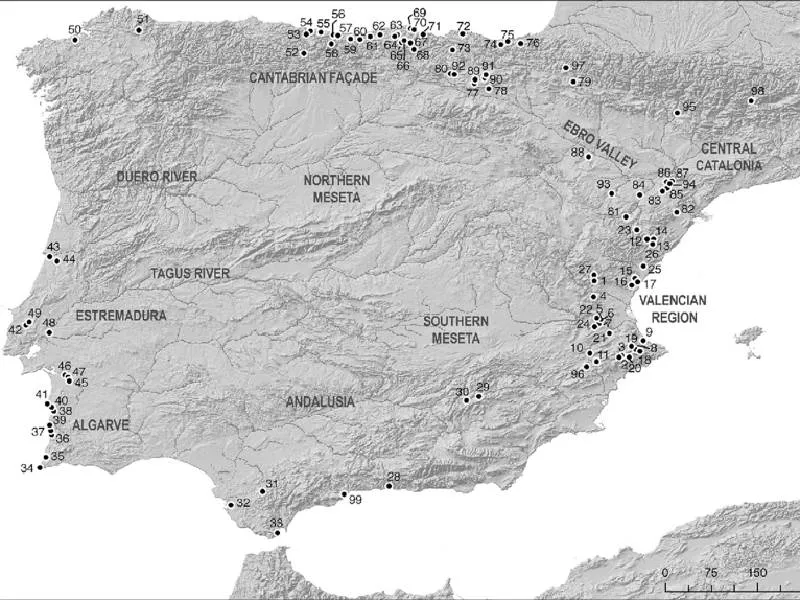
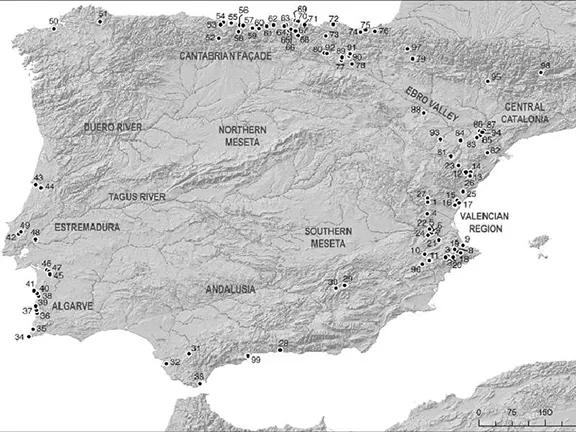
Late Mesolithic sites in the Iberian Peninsula
This was to be a rocky road for most hunter-gatherers in the Iberian Peninsula. Instead of increasing gradually, in less than 200 years from about 14.7 kya temperatures made a sudden leap of up to 15C. A fairly rapid reversal followed, taking temperatures back down to the levels of those before the rise over the next 1800 years. Temperatures then again rose gradually until about 11.7 kya, then increased by 15C over a period of less than 200 years.
As can be seen from the charts in the pdf accompanying the previous article, the climate changes had a dramatic effect on the number of Magdalenian sites. Over this series of oscillations, there is little difference between the north and the south of the Peninsula. The number of sites grows dramatically after 15 kya, reaching a peak about 14.2 kya. Numbers then drop gradually until the Magdalenian tool industry disappears about 11 kya.
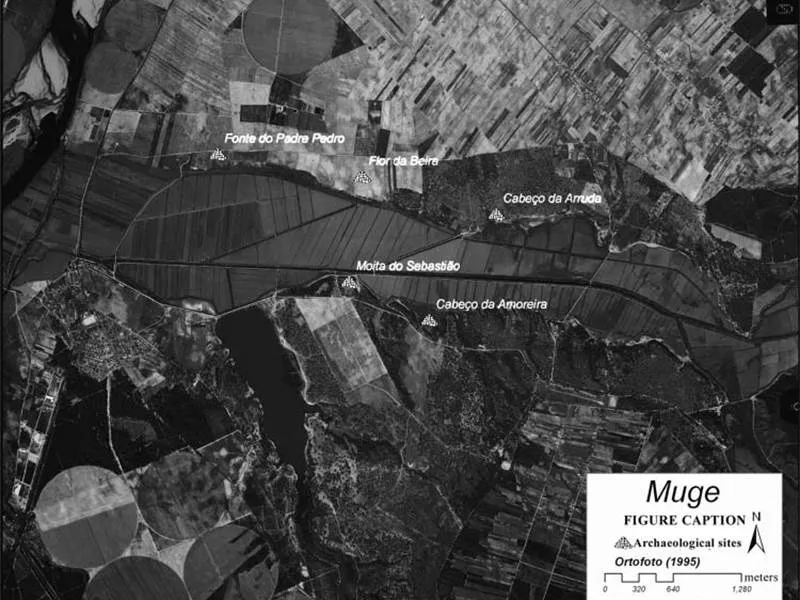
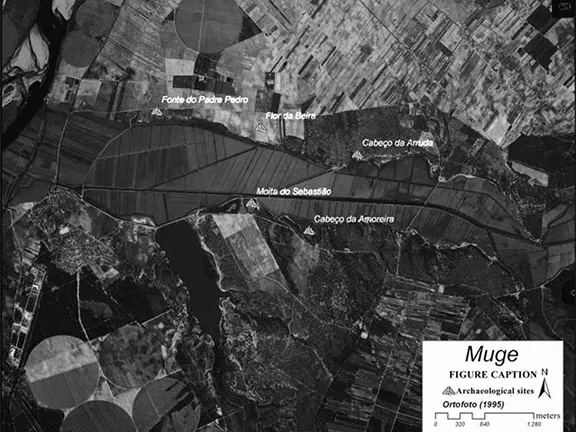
Muge Shell Middens
Archaeological excavations reveal that, about 15 kya Nerja cave suddenly jumps back into view with a dramatic increase in marine fauna compared to the previous, lower, Solutrean levels. The coast at this time was about 4 kilometres from the cave compared to 6 kilometres during the Last Glacial Maximum. Molluscs predominate accompanied by members of the cod family; the waters were still much colder than today. Amongst the remains of the birds, both terrestrial and aquatic, is a now extinct (since 1844 AD) great auk, it was easy prey being a flightless seabird, similar but not related to the penguin. Dolphin and whale remains, probably from stranded animals rather than actively hunted, as well as whale barnacles that grow on the black whale, another denizen of colder waters were also found in the cave. Ibex and red deer featured on the menu along with piñones, nuts from a pine tree, still eaten to this day. Somewhat later, in levels corresponding to about 12 kya, grinding stones and large amounts of seal remains appear.
Along the Mediterranean coast, sites at Hoyo de la Mina and Complejo de Humo (Malaga) show evidence of marine exploitation during this period. Inland, the Pirujelo cave (Cordoba) is re-occupied by people eating rabbit, ibex, red deer and wild boar. Grinding stones, indicating the exploitation of wild grains and nuts, have also been recovered.
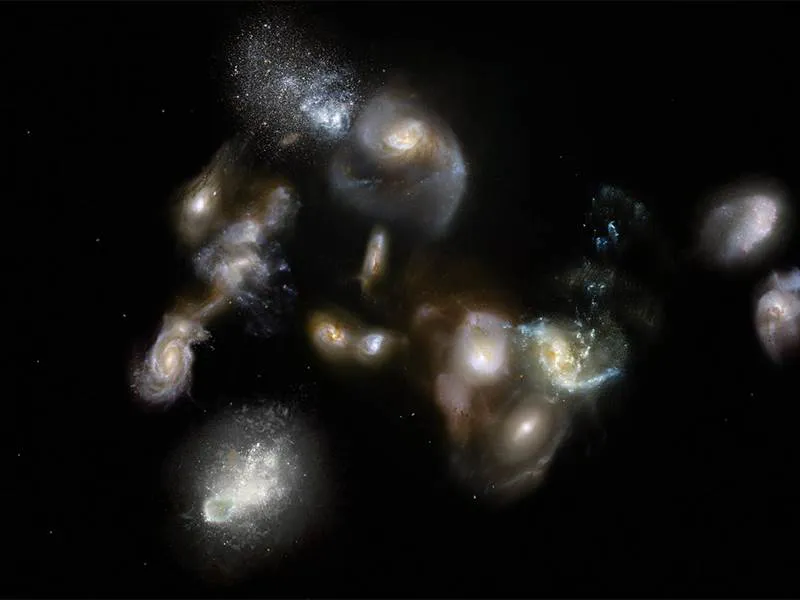
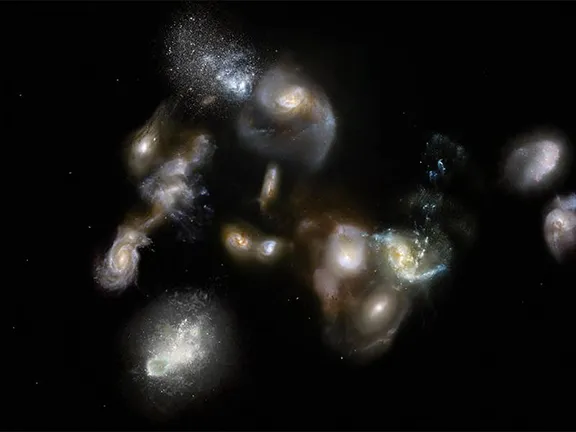
Galaxies Forming
The late Magdalenian occupation of Andalucia was accompanied by increased occupation levels in the rest of the Iberian Peninsula. The original networks and routes, established, and at times only tenuously maintained, over the previous 33,000 years saw an uptake in the transmission of material culture, mainly flint and seashells. Flints travelled from outcrop sites on the northern flanks of the Pyranees, via passes now becoming useable, to Catalunya and Aragon. Mediterranean mollusc shells appear in Cantabria. Marine shells from both the Atlantic and Mediterranean, used as beads, are numerous at Estebanvela, which is situated in the centre of the Peninsula. Engraved pebbles also linked this site with coastal sites in Iberia and France. Distinctive ‘Mediterranean’ barbed points on harpoons were a shared technology from Catalunya to Malaga.
This period also saw evidence of potential contact between Andalucia and North Africa. A bone harpoon, of typical ‘Mediterranean’ barbed point design, turned up in a 12th millennium BC layer at Taforalt Cave in Morocco. It could have been picked up off the beach, flotsam taken home by a child, it could have been embedded in what must have been a rather large fish that escaped, or it could indicate physical communication across the Gibraltar Strait.
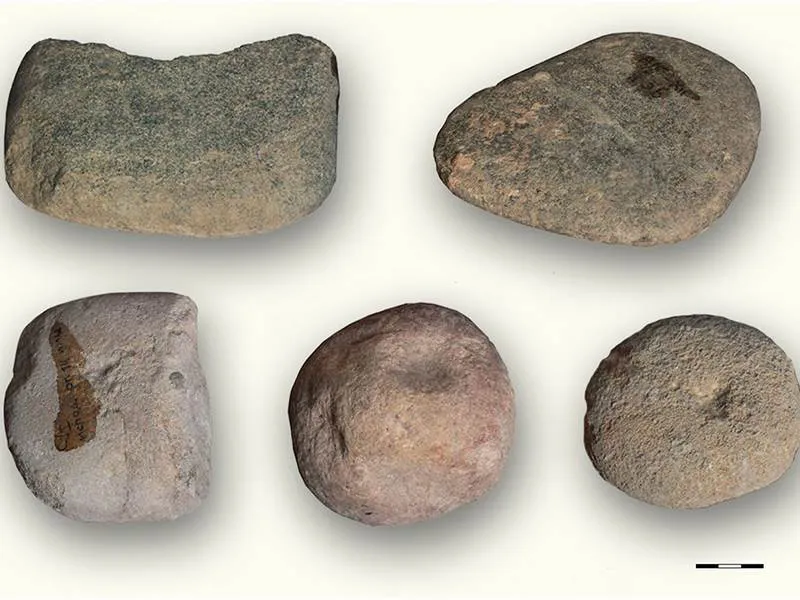
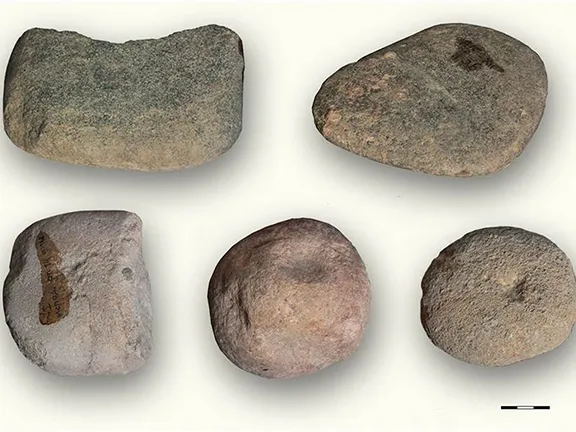
Mesolithic grinding stones
The Magdalenian period, like the Solutrean before it, is known for its art. Cave paintings concentrated in the Cantabrian coastal sites with stylized images of long horned ibex and anatomically perceptive views of other animals including horses and bison. The Cantabrian sites are also renowned for their portable art, detailed figures of animals on bones and on stone plaques. In Alicante a spatulate bone pendant with complex geometric decorations suggests, to some people, notational activity. Only Andalucia remained plebeian during this period, an indication that population levels were still very low during this late Magdalenian period.
Temperatures started to rise again after 12.7 kya and gradually the population of Andalucia started to increase. A shell midden at Nerja cave was started about 10,980 BC and continued to grow until 9,360 BC. Periwinkles and bivalves, including scallops, predominate together with the remains of fish including haddock and cod, marine birds including the great auk, several monk seals, ibex, red deer, boar and the by now, ubiquitous across the Peninsula, rabbit. The marine species and the great auk are associated with cold water, sea temperatures tending to lag behind average air temperatures. Haddock is found today off the Norwegian coast and cod in the North Atlantic. In amongst the trash were perforated shell ornaments, the first evidence of portable art in Andalucia for many generations.
About 9,500 BC, average temperatures rose several degrees in a single generation. Pollen records show that, in Andalucia, the warming, more humid climate, saw the expansion of deciduous oak Mediterranean woodlands. Plant species that had been sheltering in protected enclaves started to emerge, the olive tree re-appeared after a brief resurgence around 20 kya, birch, walnut and ash trees started to populate the slopes along with cork oak. In excavated caves, the remains of roe deer and boar became more plentiful along with ibex, red deer and horses. Vetch, a member of the pea family, started to appear on menus. The gorses and herbs, rosemary, thyme and sages put down roots on the poorer limestone slopes. The landscape gradually assumed a familiar pattern.
A second consequence was the gradual disappearance of the coastal plains, reducing the habitable area available.
Whilst the increases in temperatures was beneficial to coastal communities, those on the Meseta found that they were in an increasingly unhospitable environment. The Meseta lacked any important lakes and the few rivers dried out in the summer, despite heavier precipitation than today. In addition, the vegetation developed into a dense temperate forest. The Meseta was abandoned and would not be populated again until about 4000 BC, by farmers.
The improvement in the climate had dramatic consequences for occupation sites in Portugal. These is dealt with in some detail because those sites were to have significant influence on events in Andalucia in just a few thousand years.
Prior to 9,500 BC, the Portuguese occupation sites located more than 10 kilometres from the sea did not contain shell middens. Afterward, most of the sites were shell middens or else they contained a significant shell-midden component, even if they were located at distances from the sea in excess of 40 kilometres. Given the distances involved, the accumulation of coastal and estuarine resources at such inland sites cannot have been related to procurement within the immediate environs of the area. It is more likely that the sites were seasonal or functionally specialised sites and the midden grew from the debris of food from the coast that had been consumed immediately on arrival at the site.
Movement by water inside such territories must have been relatively easy and fast. Fed by precipitation well above that of the region's present-day Mediterranean climate, the rivers and streams of the Early Mesolithic flowed through freshly incised valley bottoms and therefore must have been larger and deeper, making for practical communication routes if canoes were used. The canoes illustrated are modern constructions based on the design of a late Mesolithic canoe found at Pesse in the Netherlands dated to between 6040BC and 5510 BC.
An implication of the Portuguese evidence is that, by comparison with periods before the 9,500 BC warming event, not only population densities but also the overall population size must have decreased in the Early Mesolithic or at least remained static. The area available for settlement became significantly reduced by the rise in sea level. Nevertheless, the size of economic territories seems to have increased overall with inland sites with shell middens implying an inland residence for part of the year and coastal residence for the remainder.
A reasonable analogy for the Mesolithic sites in Portugal may be found on the opposite side of the world and some 11,000 years later.
Anthropologists often use data gathered by researchers working with ‘traditional’ hunter-gatherers, ‘discovered’ by the explorers of the 18th – 20th centuries. These were populations in remote areas of the world that still enjoyed a hunter-gatherer lifestyle that had remained unchanged until, in some cases the early 20th century.
Along the northwestern and southwestern coasts of seventeenth-century aboriginal Tasmania, individual bands of up to 50 people wintered at residential camps situated at intervals of about 50 to 100 kilometres and placed in the major estuaries of this 1,000 kilometre long coastline. This seems to be a reasonable settlement analogy for the Iberian Mesolithic, at least along the Atlantic, where human adaptations operated under similar environmental constraints and with a similar economic basis.
Temperatures continued to rise throughout the northern hemisphere until, about 6200 BC, the climate was slightly warmer and wetter than it is today.
The Portuguese settlements moved to the inner parts of the estuaries of the rivers, Mondego, Tagus, Sado and Mira. Over the 1500 – 1750 years that these sites were occupied, massive shell middens were created that, in area and height, transformed the topography of the landscape. The Muge (in the Tagus estuary) midden sites became permanent or near permanent settlements. The middens were also used as cemeteries, indicating an awareness of ownership by the band rather than being a shared resource. In this area of the Iberian Peninsula at least Mesolithic bands had put down roots.
Returning to Andalucia, between Gibraltar and Valencia, cultural continuity is clear from the sites that date to between 9500 BC and 5500 BC. The Magdalenian tool industries developed seamlessly into what is called Mediterranean Microlaminar Epipalaeolithic. This is characterised by a decrease in the size and variety of small blade armatures and the appearance of a few types of backed elements. Backed elements are asymmetrical, one edge will be sharp, the opposite rounded off. Their advantage is that many different types of tool can be made from one pattern of backed element. The use of bone tools correspondingly dropped. Somewhere around 7500 BC, small sized geometric microlithic armatures (triangles, trapezoids, crescents) started to appear. It is thought that microliths were mounted on wooden shafts and held in place by resin. Shafts, such as spears, could have multiple microliths, increasing their penetrating potential making them very effective weapons. Light projectiles such as harpoons, javelins and arrows would all have improved. Unfortunately, the wooden shafts of these weapons tended to rot so researchers are left with only the blades to ponder over.
In Nerja cave, the remains in the shell midden inaugurated about 10,980 BC show that, after 9500 BC, the marine resources became even more important. The cold water fauna is augmented by more seals and birds such as ducks and partridges. Seasonal indicators, nuts, grain, fruits etc., show that Nerja was seasonally occupied in autumn and winter, which suggests that marine resources were more important during those seasons. The summer camps and activities were probably in open air sites that have still to be identified.
The second site along the Mediterranean seaboard that displays semi-permanent occupancy with a shell midden is El Collado near Oliva in Valencia province. The site centres around a rock shelter that is currently 70 metres above sea level, 3.1 kms back from the coast. The excavated midden extended to about 150 sq metres. During the Younger Dryas, 13.2 kya to 11.7 kya , sea levels here were 60 m lower than today. As temperatures increased, the terminal coastal plains were flooded and that led to the development of freshwater swamps and brackish lagoons, the Pego-Oliva marshes. The maximum extent of this marine transgressive period occurred between 6300 and 4130 BC. At that time the sea level was 2 m higher and 3 km inwards from where it is today.
Occupation started about 7443 BC and ended about 6200 BC. The midden is remarkable for its freshwater mollusc content and land snails. The snails, Sphincterochila candidissima, a medium sized, edible gastropod, inhabit the arid and semi-arid zones of Mediterranean Spain and live on bushes that have adapted to life with a limited supply of water, such as the caper. Fish species are dominated by the presence of the gilthead sea bream.
Of the 15 bodies found in the midden, 10 were interred between 7744 BC and 6545 BC. All 15 were buried in pits. There is no record of any grave goods. El Collado is, at the moment, the oldest Mesolithic cemetery in the Iberian Peninsula. It appears that, even from this early date, humans were laying claim to their territory.
Although some sites may now be beneath the sea and lost to us, it appears that Nerja cave was the primary site in Andalucia. Whether the Mesolithic community regarded it as such is unknown. Other sites, of which there are still few as we approach the 6.2k year event, include Bajondilla, Palmones and Retamar (considered by some to be Neolithic) all with evidence of increasing exploitation of marine resources. It should also be mentioned that recent studies to try to ‘fill’ the interior of Spain, the Meseta, with proof of late Mesolithic populations has to date (2020) failed with only sparse and doubtful evidence from sites bordering the Meseta itself. To date, in Andalucia, the furthest inland as we approach the 6.2k BC event are Frailes, Nacamiento and Valdecuevas, all open air or rock shelter sites with stone tools.
Part of the reason for lack of evidence of occupancy in Andalucia during this late Mesolithic period appears to be lack of research. The second reason could be that many coastal sites on the previously uncovered coastal plain are now flooded. Even so there should be more material to work with. An alternative suggestion is that the very shaky population levels well recorded just before 16 kya, detailed in the previous chapter did not recover to any great extent in the extreme southwest of the Iberian Peninsula over the following 10,000 years, despite an improving climate, simply because there were not enough people, who were too dispersed over the landscape, to effect an effective recovery.
About 6,200 BC, a huge amount of cold, fresh water, was released into the North Atlantic. Two hypothesise have emerged to explain the event.
• An outburst of cold fresh water from the proglacial lakes Agassiz and Ojibway draining into the Labrador Sea between Quebec and Greenland
• Rapid sea cooling following the rapid collapse and melting of an ice saddle that linked domes over Hudson Bay in North America.
The release may have changed the course of the warming Gulf Stream which is part of the North Atlantic thermohaline circuit and resulted in a rapid decrease in temperatures in Europe of between 10C and 50C in less than 20 years. The coldest period lasted for 60 years after which the thermohaline circulation in the North Atlantic re-established itself and temperatures returned to those before the event. The entire event lasted 150 years. Sea levels rose very abruptly by up to 4 metres.
Fortunately for an already distressed population, the effects of this, according to paleoenvironmental records, in the south of the Iberian Peninsula were negligible, amounting to a 10C drop in temperatures.
However, between 5800 and 5300 BC a climate change did occur that was to have profound consequences. Temperatures dropped approximately 30C and sea temperatures dropped 20C. At the same time precipitation reduced. These cold and arid conditions spread eastwards, reaching the Eastern Mediterranean by about 4500 BC.
In the Guadiana estuary, in western Andalucia, plants that had evolved to exist in arid conditions thrived along with heathers. Pine and oak trees declined, as did ash and olive. The coastal regions became too dry to support deciduous forests that moved to higher elevations.
At the same time, sea level rises inundated the estuaries of the Guadiana and Guadalquivir, submerging any settlements in those estuaries. On the Mediterranean coast, one site that maintained a population during the earliest part of this climatic period, Nerja cave, saw a reduction in the cold-water fish and some sea mammals, notably the porpoise, that had, until then, provided a substantial portion of their diet.
Late Mesolithic sites from which dates have been determined are Nerja cave and Bajondilla in Malaga province, Embarcadero del Rio Palmones and El Retamar in Cadiz province, Nacimiento and Valdecuevas in Jaen province and Ambrosio cave in Almeria. Of them, Nerja and Bajondilla caves have been subject to recent studies. It has been established that there was a discontinuity of occupation that lasted up to 500 years in these latter two sites. At Rio Palmones and El Retamar, the Mesolithic traditions seem to have continued a short time before a discontinuity of up to 500 years followed by Neolithic practices.
One area that seems to have escaped the worst of these climatic extremes is the western coast of Portugal. There the Muge shell midden sites survived relatively intact in the estuaries of the Tagus. The Mesolithic populations may also have been bolstered by people moving in from other shell midden sites that had been flooded as a result of rising sea levels, and possibly, even, other coastal sites with less favourable ecosystems, thus boosting the population numbers up to sustainable levels in this area.
Despite being an area, and time, of intensive research over the last 50 years or so, only 175 dates covering this early Neolithic period have been recorded from 25 sites in Andalucia. More than half are concentrated at four sites: Murciélagos at Zuheros, Nerja cave, Los Castillejos and El Toro. Evaluation of these dates suggests that the Early Neolithic period began around 5500 BC, right in the middle of this sudden cold and arid spell.
In Andalucia at least, it appears that the way was clear, over huge tracts of land, for the Neolithic incomers to settle without infringing on the minimal territories still occupied by the Mesolithic hunter-gatherers.
One last note. The collecting of as much of the current research available as possible leads me to think that humans act is some ways like galaxies. Galaxies form from dust in space. Particles are attracted to each other by their minute gravity until they form comets, meteors and planets with large gravities that attract even more particles. Eventually, one or more planet becomes a sun around which all else circulates. Humans, dispersed in small numbers, had to meet occasionally if only to find mates. As populations grew humans clumped together with a relatively large central group and satellites around them. Space existed between the central group and associated human satellites and between the satellites. It was not until the Neolithic that those empty spaces became populated and the central group became of such a size that a society developed.
Bicho, Nuno & Umbelino, Cláudia & Detry, Cleia & Pereira, Telmo. (2010). The Emergence of Muge Mesolithic Shell Middens in Central Portugal and the 8200 cal yr BP Cold Event. Journal of Island & Coastal Archaeology. 5. 86-104. 10.1080/15564891003638184.
Fernández-López de Pablo, Javier & Gabriel, Sónia. (2016). El Collado shell midden and the exploitation patterns of littoral resources during the Mesolithic in the Eastern Iberian Peninsula. Quaternary International. In Press, Corrected Proof. 10.1016/j.quaint.2015.11.100.
Fernández-López de Pablo, Javier & Puche, Magdalena. (2009). Climate change and population dynamics during the Late Mesolithic and the Neolithic transition in Iberia. Documenta Praehistorica. 36. 67-96. 10.4312/dp.36.4.
Gibaja, Juan & Subirà, M. & Terradas, Xavier & Santos, F.J. & Agulló, Lidia & Gómez-Martínez, Isabel & Allièse, Florence & Fernández-López de Pablo, Javier. (2015). The Emergence of Mesolithic Cemeteries in SW Europe: Insights from the El Collado (Oliva, Valencia, Spain) Radiocarbon Record. PLoS ONE. 10. 1-18. 10.1371/journal.pone.0115505.
Jordá Pardo, Jesús & Avezuela, Bárbara & Aura Tortosa, J. & Martín-Escorza, Carlos. (2011). The gastropod fauna of the Epipalaeolithic shell midden in the Vestibulo chamber of Nerja Cave (Málaga, southern Spain). Quaternary International. 244. 10.1016/j.quaint.2011.04.038.
Martín Socas, Dimas & Massieu, María & Caro, José & Rodríguez-Santos, F.. (2017). The beginning of the Neolithic in Andalusia. Quaternary International. 10.1016/j.quaint.2017.06.057.
Sánchez, Miguel & Jiménez-Espejo, Francisco & Simón-Vallejo, Maria & Gibaja, Juan & Carvalho, António & Martínez, F. & Rodrigo-Gámiz, Marta & Flores, JA & López-Sáez, José Antonio & Peña-Chocarro, Leonor & Carrión, José & Morales-Muñiz, Arturo & Roselló, E & Riquelme, J.A. & Dean, Rebecca & Salgueiro, Emília & Sánchez, Rafael M & de la Rubia de Gracia, Juan & Bicho, Nuno. (2012). The Mesolithic–Neolithic transition in southern Iberia. Quaternary Research. 77. 221-234. 10.1016/j.yqres.2011.12.003.
Simón-Vallejo, Maria & Sánchez, Miguel & Espejo, Francisco & Gibaja, Juan & Carvalho, António & Martinez-Ruiz, Francisca & Rodrigo-Gámiz, Marta & Flores, José-Abel & López-Sáez, José Antonio & Peña-Chocarro, Leonor & Carrión, José & Muñiz, Arturo & Izquierdo, Eufrasia & Riquelme-Cantal, Jose & M.Dean, Rebecca & Salgueiro, Emília & Sánchez, Rafael M & de la Rubia de Gracia, Juan & Bicho, Nuno. (2012). The Mesolithic-Neolithic transition in southern Iberia: A Maghrebian? neolithisation wave coupled to the 7.4 cal ka BP climatic event. Quaternary Research. 77. 221-234.
Weniger, Gerd-Christian & De Andrés-Herrero, María & Bolin, Viviane & Kehl, Martin & Otto, Taylor & Potì, Alessandro & Tafelmaier, Yvonne. (2019). Late Glacial rapid climate change and human response in the Westernmost Mediterranean (Iberia and Morocco). PLOS ONE. 14. e0225049. 10.1371/journal.pone.0225049.
To read the full pdf with all images and maps click here